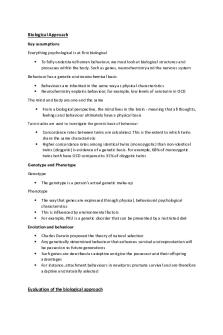Literal Approach PDF

| Title | Literal Approach |
|---|---|
| Author | Crystal Zhang |
| Course | Business Entities |
| Institution | University of New South Wales |
| Pages | 2 |
| File Size | 71 KB |
| File Type | |
| Total Downloads | 96 |
| Total Views | 143 |
Summary
This document is aimed at taxation law approaches....
Description
Literal Approach Literal Rule is where the judges interpret the legislation that the Parliament has used. “An example of this rule is a Law to Prohibit the Sale of NumChucks, where anyone who sells the items and gives that item to someone else commits an offence”. Such as A Police officer walks pasts a shop and finds one on the window, they take down the details of the shop and subsequently prosecuted for selling the illegal Numchucks. When it goes to court the Shopkeeper will point out that has not been sold or lent or even given, but there has not been a crime committed under the act, that it has not been intended to prohibit these numchucks from being Freeling displayed for sale and the words in the statute has caught this actual activity. Where then the court interprets literally that the statute has not caught this particular transaction. This approach has been actually used in the case of Fisher v Bell (1961)
Golden Rule Is where the courts adopt a meaning that reflects the purpose of the legislation. This not an Exclusive purpose of the law and it is not an easy one. The in consistence often arises because of parliament amends the provisions from the act. An example of Golden Rule is in a case called Inland Revenue Commissioner’s v Hinchy ( 1960) as where the tax act stated if the taxpayer submitted inaccurate tax return the taxpayer would be penalised to the extent of” Treble the tax ought to have been paid”, overall the taxpayer said that the policy of this law was to prevent underpayment of tax.
Mischief Rule Approach It is where a Statute assumes to pass an order to overcome some certain defects in the common law. As where the Courts must identify the defect and were they need to interpret the legislation as having an intended problem to overcome that certain problem. An example of this rule is in the case of Heydan’s Case (1584) 3 Co.Rep 7 a; 76 E.R. 637: Similar case of this approach was given in Smith v Hughes (1960) IW.L.R at 830. It deals with the Street Offences Act, where it states that the common Prostitute to loiter of solicit in a street for the Purpose of Prostitution, where a Street indicated that it was a place and not a person. The overall case was to deal with
cleaning up the streets, for people to walk along the streets without being molested or solicited by prostitutes. The prostitute would be penalised and arrested and would be found guilty of the offence, if they were to be soliciting in the streets.
The Difference between the Three Rule Approaches The difference between the above is the generally the courts are abound to take the literal rule approach to the legislation, but it is possible to do so to depart from this approach, where significant reason why they should, where they can use the Golden Approach and Mischief rile. Overall the difference is that the literal approach is the interpretation of legislation applies the general rule that a court is bound by the words within the statute, but as where the two others are concerned they are the Golden Rule approach comes in when the Judge reluctant to use this approach by using phrases of the interpretation and where the Mischief approach is where the courts use words and phrases are ambiguous or are uncertain for some other reasons, this rule come in where there is uncertainty in a case....
Similar Free PDFs

Literal Approach
- 2 Pages

Literal Approach
- 3 Pages

Literal rule and mischief rule
- 9 Pages

The Literal Rule
- 1 Pages

Literal rule - Lecture notes 22
- 2 Pages

Interactionist Approach
- 1 Pages

Biological approach
- 2 Pages

Psychodynamic Approach
- 2 Pages

Reading Materials (Fuller Approach)
- 20 Pages

Lecture 2 - Skills Approach
- 3 Pages
Popular Institutions
- Tinajero National High School - Annex
- Politeknik Caltex Riau
- Yokohama City University
- SGT University
- University of Al-Qadisiyah
- Divine Word College of Vigan
- Techniek College Rotterdam
- Universidade de Santiago
- Universiti Teknologi MARA Cawangan Johor Kampus Pasir Gudang
- Poltekkes Kemenkes Yogyakarta
- Baguio City National High School
- Colegio san marcos
- preparatoria uno
- Centro de Bachillerato Tecnológico Industrial y de Servicios No. 107
- Dalian Maritime University
- Quang Trung Secondary School
- Colegio Tecnológico en Informática
- Corporación Regional de Educación Superior
- Grupo CEDVA
- Dar Al Uloom University
- Centro de Estudios Preuniversitarios de la Universidad Nacional de Ingeniería
- 上智大学
- Aakash International School, Nuna Majara
- San Felipe Neri Catholic School
- Kang Chiao International School - New Taipei City
- Misamis Occidental National High School
- Institución Educativa Escuela Normal Juan Ladrilleros
- Kolehiyo ng Pantukan
- Batanes State College
- Instituto Continental
- Sekolah Menengah Kejuruan Kesehatan Kaltara (Tarakan)
- Colegio de La Inmaculada Concepcion - Cebu





